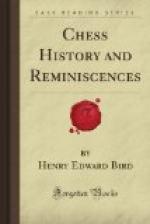The whole tenor of such reasoning as can be found in Linde’s stupendous work, seems to rest on subtle distinctions as to the precise accuracy of the word chess, rather than to valid argument to the effect that no game resembling it ever existed before the time he fixes, yet his diagrams of the Tschaturanga which comes Vol. 1 following page 423, is exactly in accordance with the game as explained to us by Sir William Jones and Professor Duncan Forbes, though Linde seems to call it by the name of Indischer Wurfelvierschach or Indische Kriegsspiel, and there is not a single diagram of what the German writer conceives it to be other than the real Tschaturanga (Chaturanga).
Note. From such an assumptive writer, one would like to ask whether he had looked through the pages of Livy Polybius and Tacitus, or explored the treasures in the Fihrist, or the Eastern Works referred to by Lambe, Bland, and Forbes, as well as Dr. Hyde and Sir William Jones.
Forbes in the body of his work roughly estimates the Chaturanga at 3000 B.C., but at page xiii of appendix, he says: “The first period (of chess) is altogether of fabulous antiquity, that is, of three to five thousand years old,” in fact, he seems to have been rather loose in his estimation, and not to have sufficiently distinguished between the supposed antiquity of the four sacred Vedas, the Epic poems, the Ramayana and the Mahabarata, and the Puranas. Professor Weber and Dr. Van der Linde assume a much more recent date for the Bhavishya Purana, from which the account of the Chaturanga is mainly taken, than that assigned to it by Sir William Jones and Professor Duncan Forbes.
------
The 4,098 name index already referred to includes Adam ten times and even Jesus three times, used, as it appears to me, rather for the purpose of irony, rather than valid or useful argument.
When Forbes gives the earliest chess position, known from British Museum M.S.S. Linde says Adam was the first chess player (??) to Sir F. Madden about 1,150, for the time when Gaimur wrote quoting the incident of the Earl of Devonshire and his daughter being found playing chess together, (Edgar’s reign 958 to 975). Linde says Madden about it “Keinen Pfifferling werth.” In another place he says, “Forbes natte der Freicheut,” “Insolence, Impudence, Audaciousness, Boldness.”
It is not pleasing to English ears to be told that George Walker is a humbug and a snob. Professor Duncan Forbes the same, and William Lewis something worse, and to find notes of exclamation and of queries (! !! ?), instead of argument opposed to the statements of such writers as Dr. Hyde, Sir William Jones, the Rev. R. Lambe, Sir Frederic Madden, and Mr. Bland.
Linde’s dealing with Forbes’ statement concerning his examination of the copies of the Shahnama in the British Museum, puts a crowning touch on his arbitrary and insulting style and furnishes an example of his notions of courtesy and argument.




